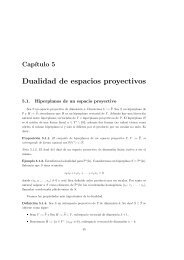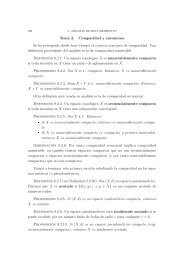TOPOLOGÍA GENERAL II - Universidad de Zaragoza
TOPOLOGÍA GENERAL II - Universidad de Zaragoza
TOPOLOGÍA GENERAL II - Universidad de Zaragoza
You also want an ePaper? Increase the reach of your titles
YUMPU automatically turns print PDFs into web optimized ePapers that Google loves.
si y sólo si lo son ambos factores.<br />
Ejercicio 05 Sea RS la recta <strong>de</strong> Sorgenfrey. ¿Cual es la topología producto<br />
en RS × RS? ¿Cual es la topología inducida en A = {(x, y) ∈ R 2 |x + y = 1}?<br />
Ejercicio 06 En R 2 , con la topología usual, se consi<strong>de</strong>ran los subespacios<br />
A = {(x, y) ∈ R 2 |xy = 0} y B = {(x, y) ∈ R 2 |xy = 1}. Estudiar si A es<br />
abierto en R 2 y en M = A ∪ B. Estudiar si U = {(x, 0) ∈ R 2 |x ∈ R} es<br />
entorno <strong>de</strong>l origen en R 2 y en M.<br />
Ejercicio 07 En R 2 , con la topología usual, se consi<strong>de</strong>ran los subespacios<br />
C = {(x, y) ∈ R 2 |x 2 + y 2 = 1} y D = {(x, y) ∈ R 2 |x = y} y sea N = C ∪ D.<br />
Estudiar si C es entorno <strong>de</strong> ( √ 2, √ 2) y <strong>de</strong> (0, 1) en N.<br />
Sea X un conjunto, {(Xi, τi)}i∈J una familia <strong>de</strong> e.t. y {fi : X −→ Xi}i∈J una<br />
familia <strong>de</strong> aplicaciones. Definimos la topología débil sobre X inducida por<br />
la familia {fi}i∈J como la menor topología que hace continuas las fi.<br />
El conjunto S = <br />
i∈J Si con Si = {f −1<br />
i (Ui)|Ui ∈ τi} es una subbase para dicha<br />
topología.<br />
2.2 Teorema Sea X con la topología débil inducida por {fi}i∈J, entonces una<br />
aplicación h : Y −→ X es continua si y sólo si fih es continua para todo i ∈ J.<br />
Dem. Si h es continua, entonces fih es continua para todo i ∈ J, ya que las<br />
fi son continuas. Recíprocamente, sea U abierto en X, entonces U es unión<br />
arbitraria <strong>de</strong> intersecciones finitas <strong>de</strong> elementos <strong>de</strong> la forma f −1<br />
i (Ui), por tanto<br />
h −1 (U) será unión arbitraria <strong>de</strong> intersecciones finitas <strong>de</strong> elementos <strong>de</strong> la forma<br />
h −1 f −1<br />
i (Ui) = (fih) −1 (Ui), abiertos en Y si las fih son continuas para todo<br />
i ∈ J, luego h −1 (U) abierto y por tanto h continua.<br />
Sea ahora X = Xi, un punto <strong>de</strong>l producto es una |J|-tupla (xi) y <strong>de</strong>notamos<br />
por pk : Xi −→ Xk t.q. pk((xi)) = xk la proyección canónica sobre el k-simo<br />
factor, entonces <strong>de</strong>finimos la topología producto τp sobre Xi como la<br />
topología débil inducida por las proyecciones {pi}i∈J.<br />
Si U ∈ τk notar que p −1<br />
k (U) = Ui, don<strong>de</strong> Uk = U y Ui = Xi para todo i = k.<br />
Una subbase <strong>de</strong> τp viene dada por<br />
Sp = {p −1<br />
i (U)|U ∈ τi, i ∈ J} = <br />
i∈J<br />
{p −1<br />
i (U)|U ∈ τi}<br />
y, si F recorre los subconjuntos finitos <strong>de</strong> J, una base para τp viene dada por<br />
Bp = { Uj|Uj ∈ τj, Uj = Xj, ∀j ∈ J − F }<br />
Dada una familia <strong>de</strong> aplicaciones {fi : X −→ Xi}i∈J, existe una aplicación<br />
f : X −→ Xi <strong>de</strong>finida por f(x) = (fi(x)), única t.q. pif = fi. Entonces<br />
4





